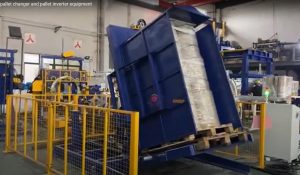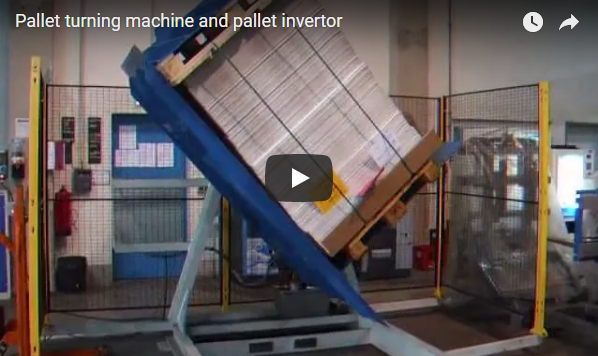Streamlining Pallet Handling: A Closer Look at FHOPE's Pallet Turning Machine and Inverter
Manual pallet handling is a persistent challenge on many shop floors and warehouse docks. Flipping heavy, awkward loads isn't just time-consuming; it's a leading cause of back injuries and product damage. Whether you need to swap out a damaged pallet, transfer goods to a different pallet type (like from wood to plastic for hygienic zones), inspect the bottom of a load, or simply rotate stock, doing it by hand is inefficient and risky. This is where dedicated pallet handling equipment, specifically pallet turning machines and pallet inverters like those offered by FHOPE, becomes a crucial investment.
Video showcasing the operation and benefits of the FHOPE Pallet Turning Machine / Pallet Inverter.
FHOPE provides a robust pallet turning machine, often referred to as a pallet inverter, designed as a practical and efficient solution for operations requiring 180-degree pallet rotation. Let's dive deeper into why this equipment is becoming indispensable in modern material handling.
1. The Daily Grind: Common Scenarios Demanding Pallet Inversion
Why would a busy facility need to routinely turn entire pallet loads? The reasons are numerous and critical to smooth operations:
- Replacing Damaged Pallets: Quickly swap a broken or unsuitable pallet without manually destacking and restacking the load.
- Load Transfer: Easily move goods from in-house wooden pallets to plastic pallets for cleanroom environments or export shipping pallets.
- Product Quality Control: Access and inspect goods at the bottom of the pallet.
- Slip Sheet Application/Removal: Facilitate the process of adding or removing slip sheets beneath the load.
- Damage Recovery: Invert loads to salvage product after a spill or damage incident.
- Product Rotation: Ensure proper stock rotation (FIFO - First-In, First-Out) for perishable goods.

pallet inverter 2. Under the Hood: FHOPE Pallet Inverter Technical Specifications
The FHOPE pallet inverter isn't just about brute force; it's engineered for controlled, safe, and efficient operation. While specific configurations vary, typical features include:
- Operation Principle: The machine securely clamps the pallet load from the sides or top and bottom, then smoothly rotates it 180 degrees using a hydraulic or electromechanical system. The original pallet can then be easily removed and replaced.
- Key Performance Parameters:
- Load Capacity: Typically handles loads ranging from 1000 kg (2200 lbs) to 2000 kg (4400 lbs) or more, depending on the model.
- Cycle Time: Efficient rotation cycles, often completing a full 180° inversion in approximately 60-90 seconds.
- Pallet Size Compatibility: Designed for standard pallet dimensions (e.g., 1200x1000mm, 1200x800mm, 48"x40"), with options for custom sizes.
- Control System: User-friendly controls, often featuring push-buttons or a simple HMI (Human-Machine Interface) for semi-automatic or fully automatic operation.
- Construction: Robust, heavy-duty steel frame built for industrial environments, often powder-coated for durability.
- Safety Features: Essential safety measures like perimeter guarding, safety light curtains, pressure-sensitive clamps, and emergency stops are standard or available options to protect operators.
3. From the Floor: Tangible Benefits & ROI
Investing in a pallet inverter translates directly to measurable improvements:
- Drastically Reduced Injury Risk: Eliminates the strenuous manual labor associated with flipping loads, significantly cutting down on musculoskeletal injuries and associated costs.
- Increased Operational Speed: What takes multiple workers minutes (or longer) to do manually can be accomplished by one operator in about a minute, dramatically boosting throughput.
- Lower Labor Costs: Frees up personnel previously tied up in manual handling for more value-added tasks.
- Product Protection: Gentle, controlled rotation minimizes the risk of product damage compared to manual methods or tilting with forklifts.
- Enhanced Versatility: Suitable for a wide range of industries, including food and beverage, pharmaceuticals, logistics, warehousing, and manufacturing.
As one warehouse manager put it, "Implementing the pallet inverter didn't just speed things up; it fundamentally changed our workflow for handling incoming goods with damaged pallets. The reduction in back strain complaints alone made it worthwhile, and the time savings were a significant bonus."
4. Customization and Integration Options
FHOPE understands that one size doesn't fit all. Their pallet turning machines can often be customized:
- Operation Mode: Choose between semi-automatic (requiring operator initiation for cycles) or fully automatic models that can integrate into conveyor lines.
- Loading Method: Options for forklift loading, pallet jack loading (floor-level access), or conveyor integration.
- Materials: Stainless steel construction is available for food-grade or corrosive environments.
- Guarding: Various safety guarding configurations to meet specific facility requirements.
5. Making the Smart Investment
The FHOPE pallet turning machine and pallet inverter represents a cost-effective investment in operational efficiency, safety, and flexibility. By automating a physically demanding and time-consuming task, businesses can achieve significant improvements in productivity and reduce the hidden costs associated with manual handling injuries and product damage.
It's a reliable, easy-to-operate machine designed to tackle a common bottleneck in material flow, ultimately contributing to a leaner, safer, and more productive operation.
For detailed specifications, customization options, or to discuss how a pallet inverter can fit into your specific workflow, reach out to the experts.
Learn more about FHOPE's pallet handling solutions:
https://www.fhopepack.com/pallet-inverter/
Contact for inquiries:
info@fhopepack.com


